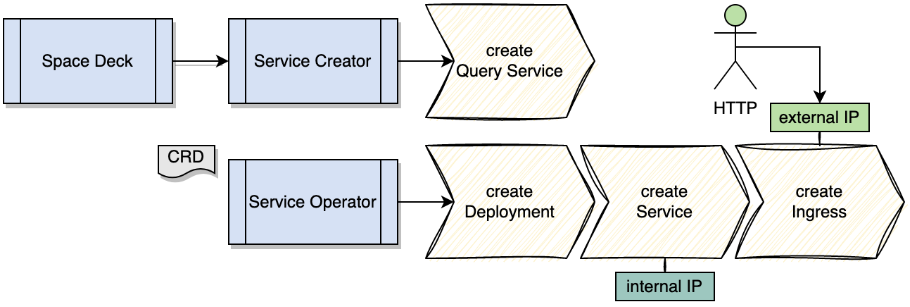Deploying Services
There are several types of Services:
-
Stateful PU
 This is a Space containing data and might also include code and services. They are displayed in all UI tools and the metrics for them are managed./Service - This is space containing data.
This is a Space containing data and might also include code and services. They are displayed in all UI tools and the metrics for them are managed./Service - This is space containing data. -
Stateless PU
 Built-in services such as mirror WAN-GW, data GW and custom services. They are displayed in some UI tools (Ops-UI/Web-UI) but NOT in SpaceDeck. Metrics are managed./Service - These are built-in services such as mirror wan-GW, data-GW and custom services
Built-in services such as mirror WAN-GW, data GW and custom services. They are displayed in some UI tools (Ops-UI/Web-UI) but NOT in SpaceDeck. Metrics are managed./Service - These are built-in services such as mirror wan-GW, data-GW and custom services -
Client Services - These are applications which interact with spaces
-
It is also possible to develop new services based on Blueprints.
Low-Code Micro-Services

The creation of low-code micro-services is relevant for Smart DIH![]() Smart DIH allows enterprises to develop and deploy digital services in an agile manner, without disturbing core business applications. This is achieved by creating an event-driven, highly performing, efficient and available replica of the data from multiple systems and applications, only. It is recommended to use this method to start stateless services.
Smart DIH allows enterprises to develop and deploy digital services in an agile manner, without disturbing core business applications. This is achieved by creating an event-driven, highly performing, efficient and available replica of the data from multiple systems and applications, only. It is recommended to use this method to start stateless services.
Through GigaSpaces SpaceDeck![]() GigaSpaces intuitive, streamlined user interface to set up, manage and control their environment. Using SpaceDeck, users can define the tools to bring legacy System of Record (SoR) databases into the in-memory data grid that is the core of the GigaSpaces system., easy low-code data access micro-services can be created. For more information, refer to SpaceDeck – Services
GigaSpaces intuitive, streamlined user interface to set up, manage and control their environment. Using SpaceDeck, users can define the tools to bring legacy System of Record (SoR) databases into the in-memory data grid that is the core of the GigaSpaces system., easy low-code data access micro-services can be created. For more information, refer to SpaceDeck – Services
Components
| Name | Function |
|---|---|
| Service Creator | RESTful |
| Service Operator | Captures the knowledge of deploying and undeploying a Query Service |
| Query Service |
Deployment: A stateless application running on a pod. The application will be deployed with x amount of replicas regardless of usage. Service: Exposes a single outward-facing endpoint to this application on the cluster (internal network) Ingress: Makes the HTTP (or HTTPS) network service available using protocol aware URIs, for example and external network |
Service Creator
Services creation is managed by a Service Creator which, functioning as a RESTful application, manages the entire service deployment cycle.
The service exposes the REST endpoints, and is deployed in the environment via the Kubernetes![]() An open-source container orchestration system for automating software deployment, scaling, and management of containerized applications. orchestration
An open-source container orchestration system for automating software deployment, scaling, and management of containerized applications. orchestration![]() This is the automated configuration, management, and coordination of computer systems, applications, and services. Orchestration strings together multiple tasks in order to execute and easily manage a larger workflow or process. These processes can consist of multiple complex tasks that are automated and can involve multiple systems. Kubernetes, used by GigaSpaces, is a popular open source platform for container orchestration..
This is the automated configuration, management, and coordination of computer systems, applications, and services. Orchestration strings together multiple tasks in order to execute and easily manage a larger workflow or process. These processes can consist of multiple complex tasks that are automated and can involve multiple systems. Kubernetes, used by GigaSpaces, is a popular open source platform for container orchestration..
Low code development of data micro-services provide our clients with the ability to deploy and execute data services efficiently.
This assumes that the micro-service runs a query on the Space![]() Where GigaSpaces data is stored. It is the logical cache that holds data objects in memory and might also hold them in layered in tiering. Data is hosted from multiple SoRs, consolidated as a unified data model. data. It enables the user to define endpoints that, per request, will run the predefined query using the supplied required parameters to get the results.
Where GigaSpaces data is stored. It is the logical cache that holds data objects in memory and might also hold them in layered in tiering. Data is hosted from multiple SoRs, consolidated as a unified data model. data. It enables the user to define endpoints that, per request, will run the predefined query using the supplied required parameters to get the results.
Any new service creation request generates a new resource of the kind QueryService by submitting a request to the ServiceCreator service .
ServiceCreator service exposes the following APIs:
-
Deploy Query Service given Spec.
-
Get service spec-parameters given its ID.
-
Get list of available services of this kind (queryService).
-
Delete service.
-
Download logs of the service (using path
/{serviceId}/logs
Flow

 In-Memory Data Grid - achieve unparalleled speed, persistence, and accuracy.
In-Memory Data Grid - achieve unparalleled speed, persistence, and accuracy.